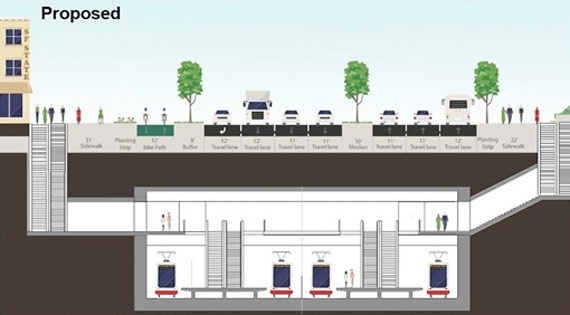M Streetcar Reconfiguration

The most recent reconfiguration of the M streetcar plan, presented in February, is a great improvement over the elevated solution that preceded it. With the M and K streetcars now going underground, congestion is relieved at both the Ocean Avenue and terrible St. Francis Circle crossings. The 19th Avenue crossing near Stonestown is eliminated, as is the one at 19th and Serra; after travelling underground all the way from West Portal, the line would finally make grade at Randolph, where the road widens. Additionally, the new configuration would feature two tracks in each direction, instead of the current single track.
Where the new M streetcar fails
Unfortunately, the new configuration ends the M line at Parkmerced, where passengers must transfer to a J train for the Oceanview district. Besides this strange inconvenience, service into Oceanview is likely to deteriorate, since it is a less well-connected neighborhood politically. Both new configurations eliminate the current stop at the Senior Center at Temple Methodist Church. Seniors and handicapped persons who have depended on the Beverly Street stop for decades will now have to find a way to another stop; this is something the neighborhood should fight. Removal of the current Lakeside stop, an option in the plan, could have a dramatic effect on the businesses there.
Why the new M streetcar line is better
In my opinion, this underground solution was necessary because the 18,000 new residents of Parkmerced would be poorly served by the previous transportation plan. It provided no solution for the St Francis Circle congestion which is probably the biggest hiccup on both the M and K lines. The dual lines in each direction will certainly speed things up, and will perhaps spur similar changes in the tunnel itself.
The elevated track of the Junipero Serra / 19th Avenue exchange would have had numerous failings. The noise created by an elevated platform would have been hard to mitigate, causing blight in at least two nearby towers. One of the elevated plans would also have the streetcar make grade on the narrow part of Randolph Street (39′ 6” wide). This would leave 11′ 6” for two rows of parking and two rows of traffic, obviously not enough space for either activity. If the section has to be elevated, better to end it at 19th Avenue.
Oceanview’s difficulties
For quite some time, Oceanview has had to endure the hardship of I-280 creating an impassible barrier along its southern border. The entrances to the neighborhood have also been minimized by traffic engineers more interested in traffic flow than economic opportunity for the residents. Also, many parts of the neighborhood were designed with “super blocks” 3 or 4 times larger than normal ones in San Francisco. These giant blocks, popular in the early 1920s, minimize the opportunity for commerce by having fewer intersections. Street corners typically encourage family and other neighborhood businesses, which is why the concept of super blocks has been abandoned by city planners.
The Oceanview district does not need a divided J line to add to its woes.
— Glenn Rogers, PLA

